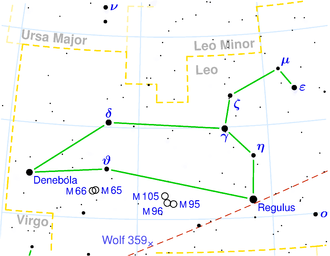NGC 3433
| Galaxie NGC 3433 | |
|---|---|
 | |
| SDSS-Aufnahme | |
| AladinLite | |
| Sternbild | Löwe |
| Position Äquinoktium: J2000.0, Epoche: J2000.0 | |
| Rektaszension | 10h 52m 03,9s[1] |
| Deklination | +10° 08′ 54″[1] |
| Erscheinungsbild | |
| Morphologischer Typ | SA(s)c[1] |
| Helligkeit (visuell) | 11,8 mag[2] |
| Helligkeit (B-Band) | 12,5 mag[2] |
| Winkelausdehnung | 3,5′ × 3′[2] |
| Positionswinkel | 50°[2] |
| Flächenhelligkeit | 14,2 mag/arcmin²[2] |
| Physikalische Daten | |
| Rotverschiebung | 0.009073 ± 0.000003[1] |
| Radialgeschwindigkeit | 2720 ± 1 km/s[1] |
| Hubbledistanz vrad / H0 | (117 ± 8) · 106 Lj (35,8 ± 2,5) Mpc [1] |
| Geschichte | |
| Entdeckung | William Herschel |
| Entdeckungsdatum | 11. März 1784 |
| Katalogbezeichnungen | |
| NGC 3433 • UGC 5981 • PGC 32605 • CGCG 066-048 • MCG +02-28-023 • 2MASX J10520382+1008536 • GC 2240 • H III 20 • h 783 • GALEXMSC J105203.86+100851.2 • NSA 158901 | |
NGC 3433 ist eine Spiralgalaxie vom Hubble-Typ Sb im Sternbild Löwe an der Ekliptik. Sie ist schätzungsweise 117 Millionen Lichtjahre von der Milchstraße entfernt und hat einen Durchmesser von etwa 125.000 Lichtjahren.
Im selben Himmelsareal befinden sich u. a. die Galaxien NGC 3428, NGC 3429, NGC 3438, NGC 3444.
Das Objekt wurde am 11. März 1784 von dem Astronomen William Herschel[3] mit einem 48-cm-Teleskop entdeckt.

Weblinks
Einzelnachweise
Auf dieser Seite verwendete Medien
Autor/Urheber: Copyright © 2003 Torsten Bronger., Lizenz: CC BY-SA 3.0
This is a celestial map of the constellation Leo, the Lion.
Autor/Urheber: Sloan Digital Sky Survey, Lizenz: CC BY 4.0
The sky image is obtained by Sloan Digital Sky Survey, DR14 with SciServer.
Angle of view: 4' × 4' (0.3" per pixel), north is up.
Details on the image processing pipeline: https://www.sdss.org/dr14/imaging/jpg-images-on-skyserver/Autor/Urheber: Judy Schmidt, Lizenz: CC BY 2.0
It really pains me to spot a galaxy like this in the archive. This is just how the old WFPC2 did things. You need at least two different frames to complete a larger object but there's a whole bunch of them that only got one so they all look just like this.
NGC 3433 is almost perfectly symmetrical. It's so symmetrical you could clone the data, rotate it 180 degrees to cover just the black L and it would look like a complete galaxy with minimal touch-up to make brightness match. It was tempting to upload a version like that but it would be way too easy for the image to be taken out of context and for people to think that the data was actually there when it's really just cloned.
I increased the saturation to create a greater range of color. I also increased the sharpness of the dust so you can see more details.
Red: hst_08213_03_wfpc2_f814w_wf_sci Green: Pseudo Blue: hst_08213_03_wfpc2_f555w_wf_sci
North is NOT up, it's 37.7° counter-clockwise from up.




